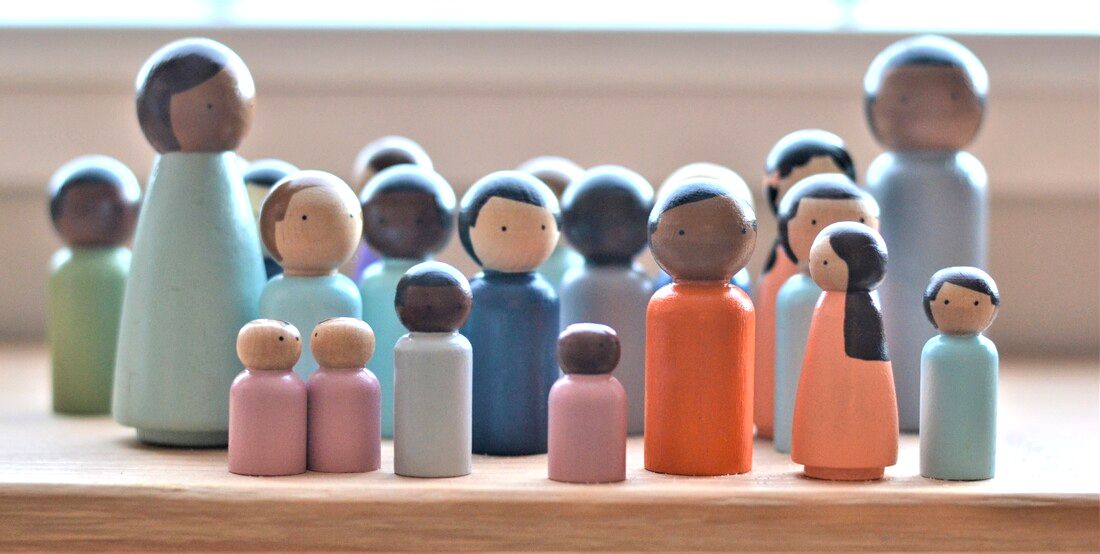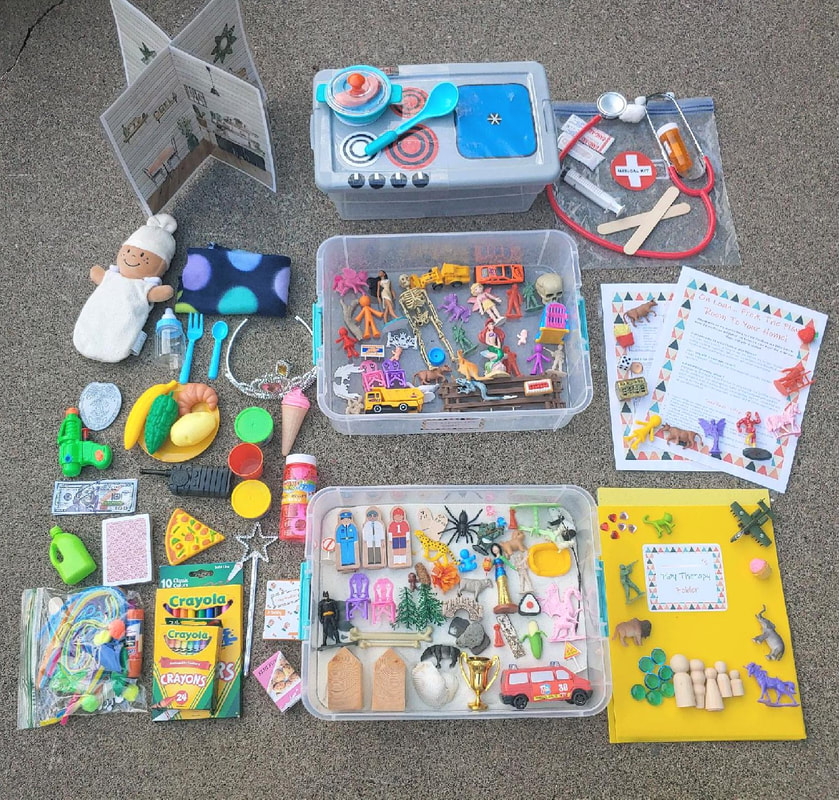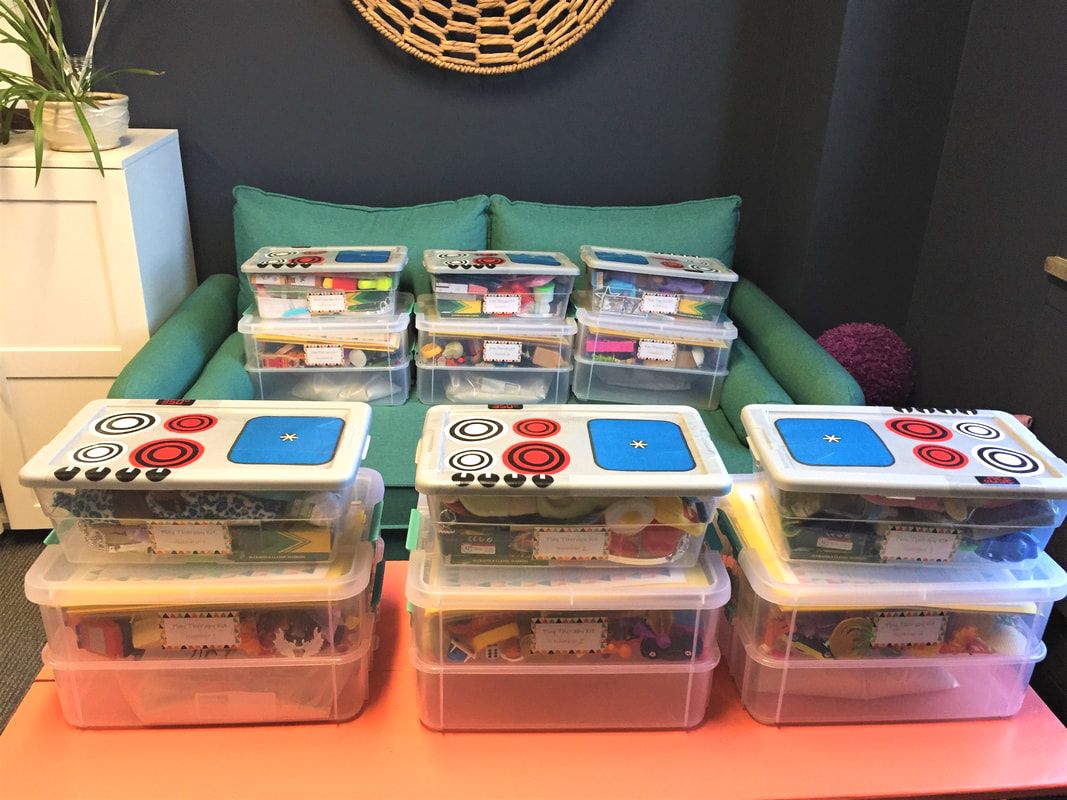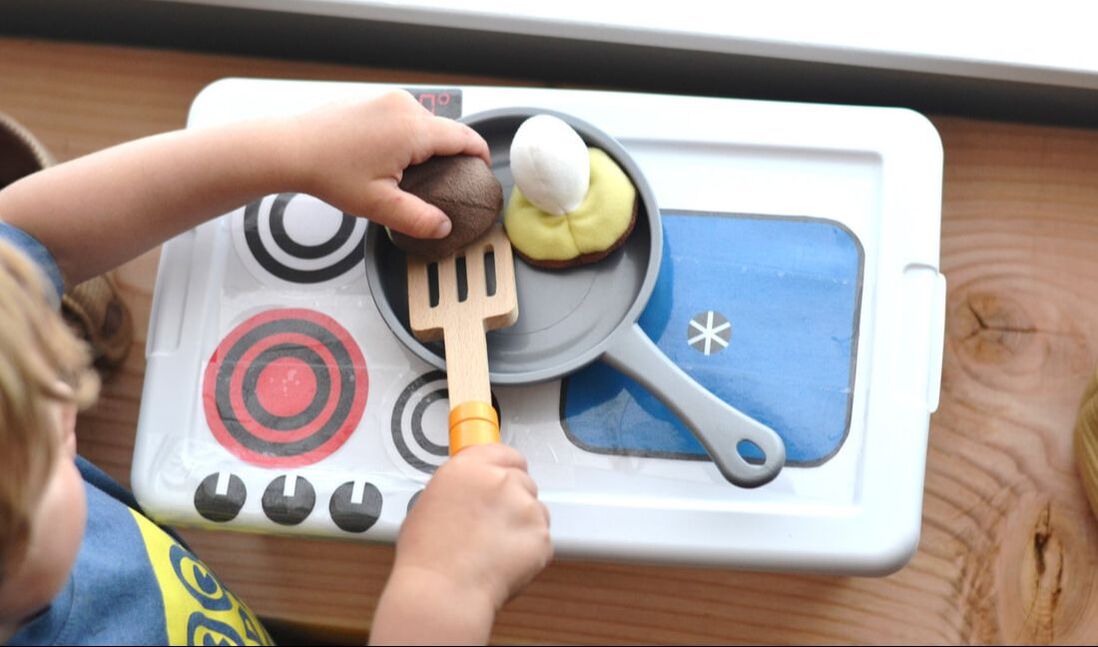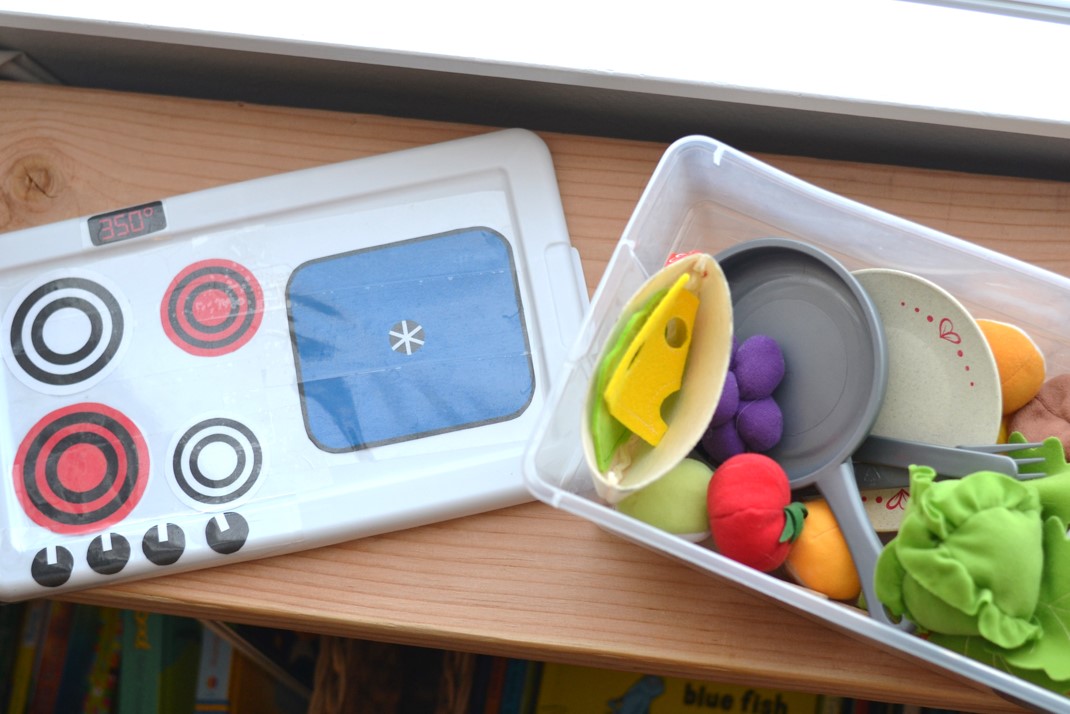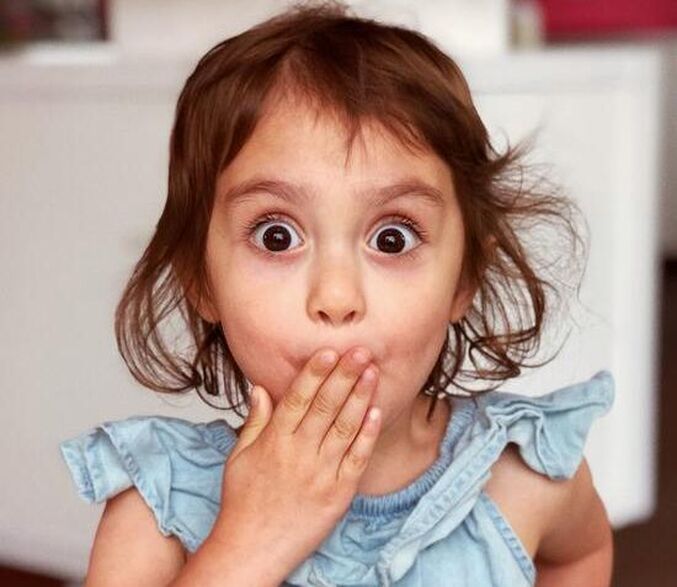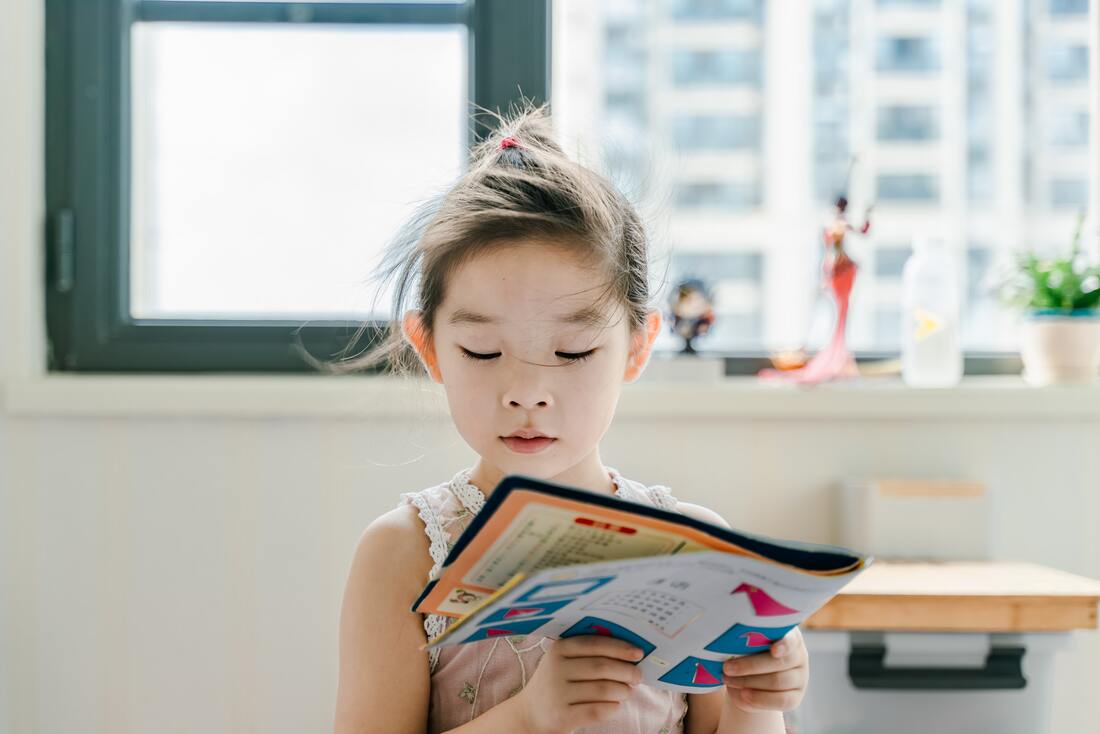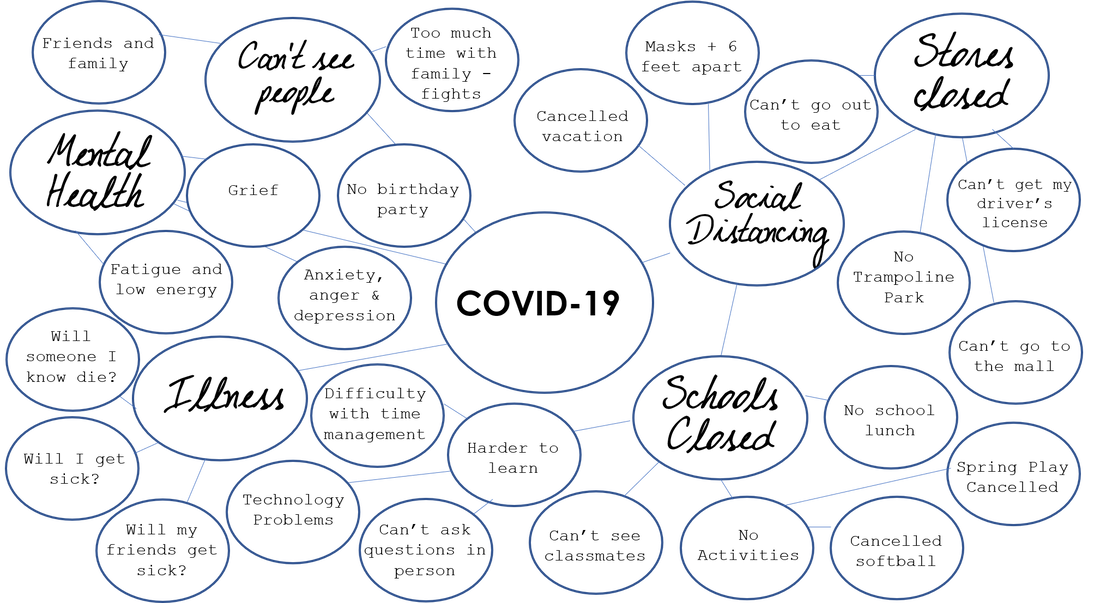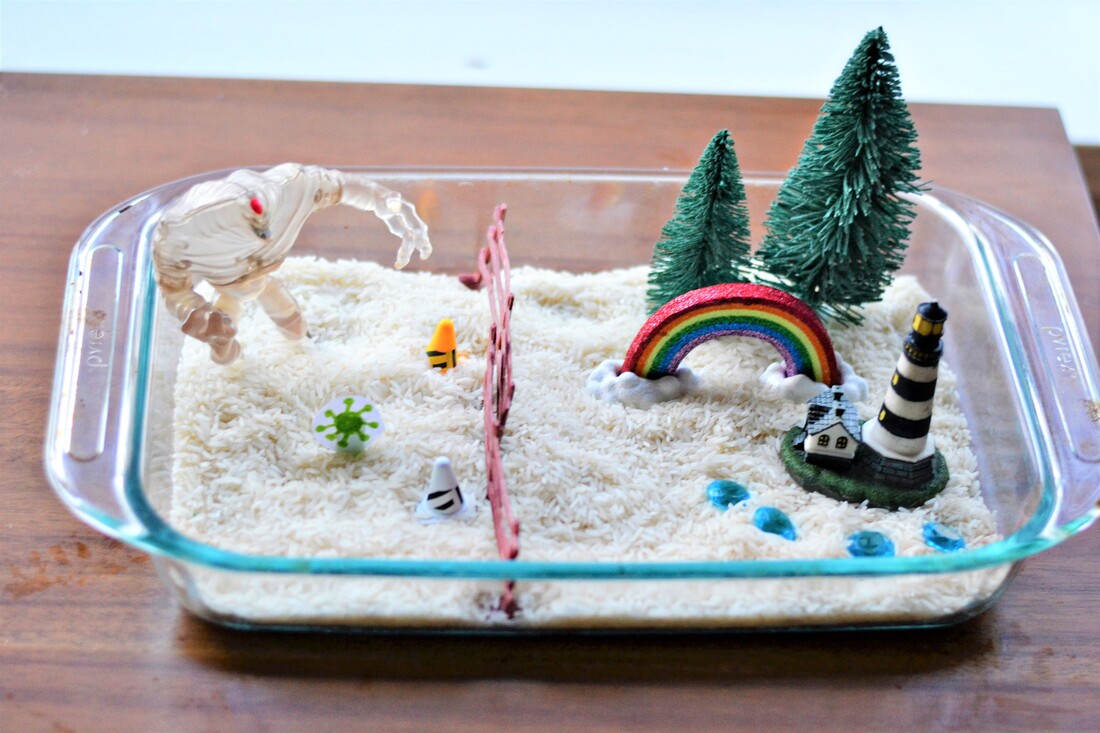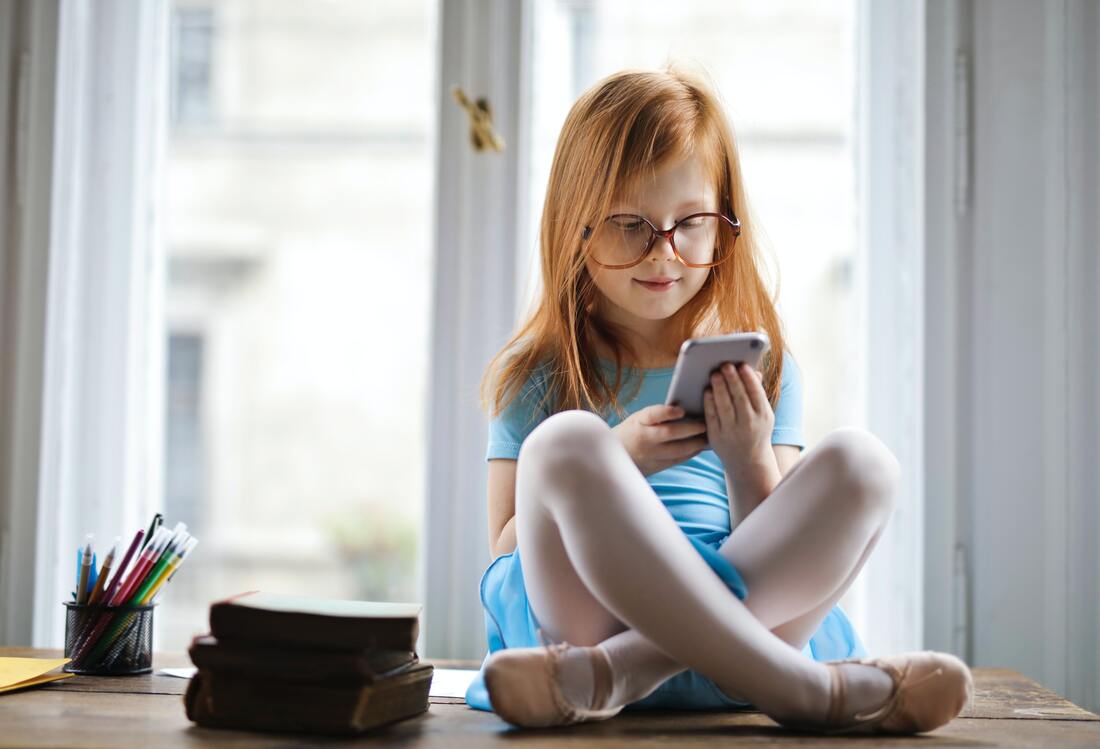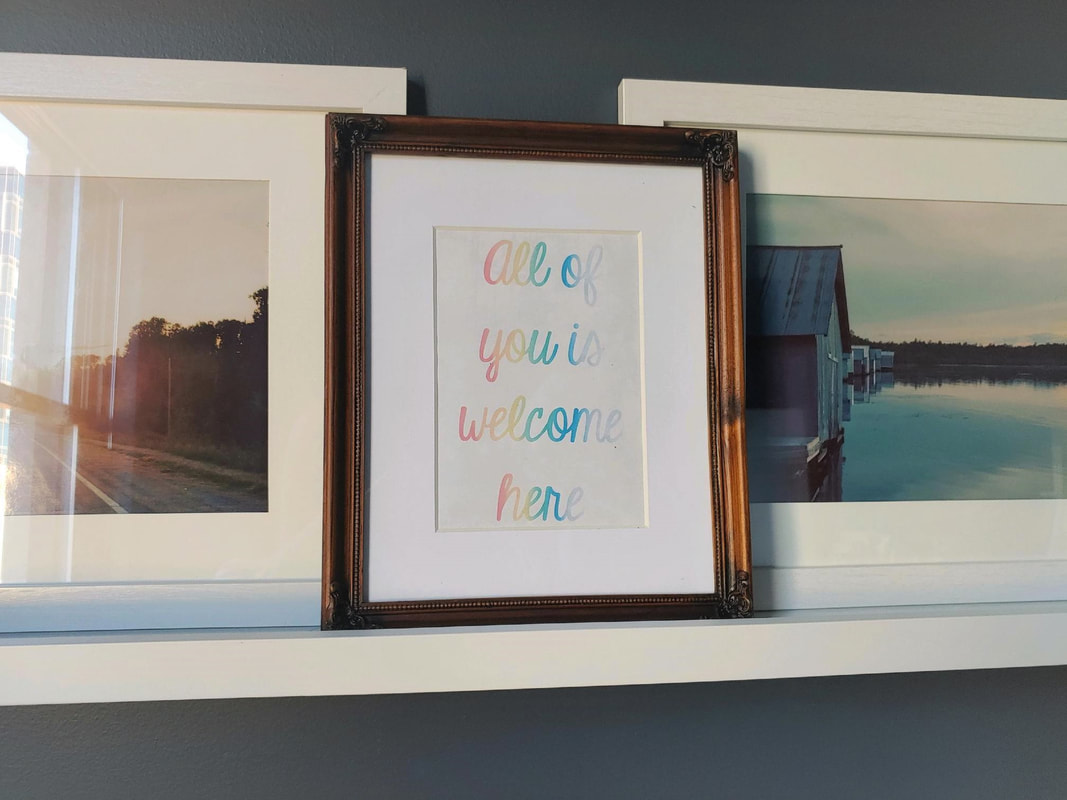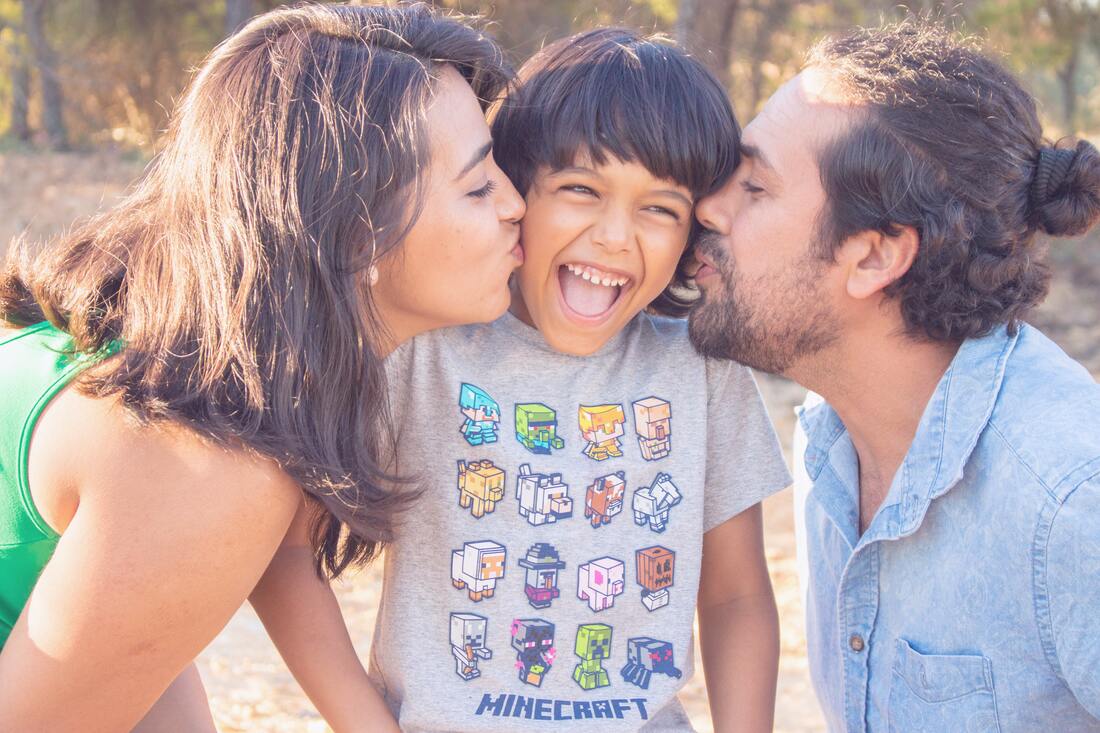|
Representation is important. It’s more than important, it is essential in your Playroom.
You need to ensure that there are multiple figures that represent each of your clients in your Playroom. When they enter your space they need to see not just one but multiple characters that they could use to reflect their experiences, should they want or need to! I wanted to round up my top 14 multicultural miniatures that I either have for my Playroom or have stumbled across in my search for toys (like in these kits HERE) that I think would be a fantastic addition to every Playroom. I would also use this as an invitation for you to take stock of your playroom and assess how clients of color will feel as they enter your space. What would they see, not see, or wish they had? These are crucial questions to be asking and continue to ask ourselves as Play Therapists. So after you do that, it’s time to get inspired! Here is my list of my Top 14 Favorite Multicultural Minis: Everyday People The “Mega Set” – This is the largest family set I have found! It includes 4 family sets (mother, father, 4 children, grandmother, grandfather) for a total of 32 figures! Sunny Doll Family - This amazingly sweet wooden doll set comes from Tender Leaf Toys and have an individual bendy doll HERE! The Modern “Mega Set” – This set includes 4 family sets (mother, father, son, daughter, baby) and is a little more spendy, but it is a much more modern family representation with outfits and clothes. OH – and it’s bendy! Both “Mega Sets” include a diverse representation of hair as well! Differing Abilities – This set includes 5 miniatures (5 inch) with different disabilities! Around The World – This set includes 8 5 inch miniatures from different countries wearing more traditional dress. Peg Dolls I purchased a large set of multicultural family peg dolls from LittleNeighbors on Etsy. I LOVE them! Buuut she is taking a break from selling right now. She always updates when her collections will be back and you can follow her on instagram at @littleneighbors for updates! (These are the miniatures in the picture up top!) I found these other listings from Elm and Otter, JustAddImaginationCo (16 miniatures for $14.00 is a steal!), and MyBigWorldPlayscapes, that are beautiful as well. OR try to make some on your own with these unfinished dolls HERE! Babies Toob Babies – these babies come in multi ethnicities with different and fun poses! They are larger and have much more detail than the mini-babies below Mini-Babies- this set includes 72 pieces of 1 inch miniatures. There are three ethnicities of babies, and although you likely don’t need ALL these babies they are at such a low price that you can afford to share with your Play Therapy besties! I got my first one for my Sand Tray from a baby shower and my clients LOVE it! Ok..now that you have looked at them they do look a little creepy - BUT my young people LOVE them and because of their size (and maybe lack of clothes, or maybe something else) these are so great for vulnerability play. Community Helpers and Professionals Constructive Playthings – this set includes 8 diverse miniatures (3 inches) with differing jobs! Constructive Playthings Wooden Set- Constructive Playthings has an additional set of wooden community helpers with differing jobs and abilities. Little Professionals – This set includes 15 wooden painted miniatures (3 inches) with differing careers. They are a bit more affordable but are not 3D figures like the others. Fantasy Fairy Toob - This is one of the more expensive TOOBs BUT it is so wonderful! There are multi ethnicities and hair types represented AND also male fairies! So there you have it! My top 14 favorite diverse Play Therapy miniatures! What did I miss? What are your favorites? Drop a comment below!
0 Comments
Playing while apart is hard. Playing together with masks and cleaning procedures is hard. Playing is pretty hard in general right now. To make it a teensy bit easier I put together a Portable Playroom In A Tote for my clients to use for play therapy sessions at home. It is a comprehensive play kit that is just a bit smaller than the actual playroom. One that fits in a tote, bag, or rolling suitcase for portability. One of the most frequent questions I get asked by new play therapists is about what toys to buy, most of the time on a budget. It is a struggle as a new play therapist to get a feel for what “should” be in the Playroom while balancing a pretty non existent budget. When it came time for me to start developing Play Therapy Kits for my clients (I talk about the process and pros and cons HERE) I felt like I was starting all over again. I flashed back to my early days of trying to cobble together something that was comprehensive, but feeling very overwhelmed by the 80+ toys that are recommended for Child Centered Play Therapy. Back I went to hours and hours of internet searching, scouring multiple Dollar Tree locations (because not every store has the same darn stuff), and attempting to match, to the best of my ability, the lists and categories of what my young people may need in a portable Playroom. It was definitely a lot of work, but easier this round than last. This kit I created for my clients is pretty comprehensive and includes all categories from Garry Landreth’s categories of toys in his text HERE on Child Centered Play Therapy. Categories of Real Life Toys, Acting Out Aggressive-Release Toys, and Creative Expression and Emotional Release. The kits are also not gendered and they are nearly identical. There is no “boy kit” or “girl kit”, because we don’t want to make assumptions about what a child may or may not need to express themselves. My female identified clients get the scary monsters, army toys, and trucks, and my male identified clients get the dolls, bottles, and princesses. In his text Play Therapy: The Art of The Relationship Garry Landreth also has a toy idea list for a “Tote Bag Playroom”. A lot of those items are included in his kit, however there are many additional items that I selected due to what I find the children I work with are drawn to most. There is also the addition of Sand Tray and miniatures (which represent the categories above as well as Sand Tray categories for miniatures) also making it a larger and more comprehensive kit. Lastly because I also do Cognitive Behavioral Play Therapy I included more directive items such as cards, a dice, stickie hands, and a folder for art and projects. However, as we know those items can also be used to do almost anything a child may want. So without further ado here is the source list for the comprehensive Play Therapy Kits: Containers: Shoe Box Tote *these appear to be out of stock but most Target, Walmart, or Dollar Tree stores carry these for around $1.00. Make sure the top is flat if you are going to create a stove on top. Check out this link HERE for a free printable to turn the top of the shoe box tote into a stove! Sand Tray Tote *If you wanted to only have one tote this would likely fit it all BUT the top isn’t flat enough to be a stove, so if you want a cooking area you might print and laminate a sheet of paper to just sit on top or the floor. Grab a set of free downloadable and printable labels for kits HERE! Orientation Handout: I created a handout to orient parents and children to the Play Therapy kits including frequently asked questions, a list of rules, and an inventory. Grab your free printable (and editable) copy HERE! Sand Tray and Miniatures: Check out this post HERE for a comprehensive list of sources for all the miniatures and sand. I included a dice in the miniature but BUT it is a great took to take out and use for Cognitive Behavioral Play Therapy. Also, if you are transporting the sand tray, store the sand it a Zip Lock bag…trust me. Toy Tote: Dish/Pot and Pan set *these have enough for silverware, a cup, and a plate for 4 kits. They only had a pot/pan for 2-3 depending on what you want in your kits, but the Dollar Tree had a set with a frying pan, egg, knife, and spatula all for $1.00 so I purchase several to supplement. Princess Kit (crown, wand, ring in a 10 pack) *For the price and number of items you get, these were much cheaper than the Dollar Tree, where it was $1.00 for one crown Babies *I LOVE that each of them has an outfit you can take off AND that they are multicultural. When I purchased they were $28.00, so watch out for a sale! The Dollar Tree also has plush multicultural dolls, but they are all female. These come in both gendered/neutral colors and the Dollar Tree ones are in dresses and not infant like. Glue Sticks, Markers, Crayons, Play Therapy Folders – at Target on discount for back to school, the BEST time to refill your art supplies! Baby Blanket *I cut up one yard piece of fleece to make over 10 blankets. You can choose any pattern or hit up a sale at your local fabric store! Doctor Kit (Stethoscope, Syringe (Dollar Tree 4 pack), cotton ball, tongue depressor, band aids (make sure if they are “skin color” all skin tones are represented. If not characters are great!), and medicine bottles. If you are only making one kit a used (empty) medicine bottle from your home or a friend/family member will work great!) Toy Gun Food (9+ items per kit) Play Money *The Dollar Tree also has play money Baby Bottle *these are meant to be party favors but you can get a TON for a great price. I had my husband drill a hole in the nipple of the bottle to make that part less of a choking hazard, even though it is fairly big. You could also hot glue the whole thing together! Printable Doll House *I designed a pop up free printable doll house that I laminated with a bathroom, bedroom, kitchen, and living room. With laminated sheets it is also super wipeable. Stay tuned for the link for the free download! Dollar Tree: Playing Cards (2 pack) Police Kit (badge and walkie talkie) * I choose to purchase these for the walkie talkies but decided to leave out the guns that came with it because although bright orange they appeared a bit too realistic Bubbles (3 pack) Pom poms (multipack) Play Dough (8 pack, 2 per kit) **Check out this post HERE for miniature items that also came from the Dollar Tree Materials from my office: I have a big craft supply at my office so I dug into the stash as well as my treasure chest for these items. Balloons Stickie Hands Pipe Cleaners Popsicle Sticks Googly Eyes Construction Paper 2 Envelopes 2 Paper Bags The Breakdown: Each kit comes in 2 containers, around 170 individual items and cost around $75.00 per kit. The great news about these kits is that I wanted to make them as comprehensive as possible so I did include a lot of stuff. It was an investment I was willing to make in my Play Therapy practice as I knew I would be playing apart for some time, and then when returning to office still likely using the kits for the first bit. Here are some of my kits ready to be picked up by clients! Seriously for how many hours I put into these I felt like I was giving away my first born child (I'm only kind of joking)! But seriously I am hoping this source list saves you a boat load of time if you are thinking about creating these for your clients! Both totes are labeled with numbers (ie Kit 1, Kit 2, etc.) so the matches can stay together and I have a list of what client is in possession of what kit. Also, the awesome thing about this source list is it is so easy to pare down. You can select less to fit your budget. Amazon also has fluctuating prices. Sometimes if you keep an eye on something and come back there will be a sale and discounted pricing. Lastly, if you are making multiple kits you can hit that price point much easier than if you were only doing a single kit, because most come in multi-packs. If you are just starting up and looking for a single kit, pair with other Play Therapists and cost share the price of the kits! Have you started the journey of Play Therapy Kits? What is your most loved item in the kit? Let me know in the comments below! Want to know more about setting up your play therapy office or practice? Check out this training HERE! Let's Connect - click here to join my email list!
How does a play stove for under $1.00 sound? Pretty awesome right? Have no fear, with this FREE play therapy kitchen printable HERE and this $0.99 tote from Target you are on your way! Imagine the sizzling sound of food cooking on the stove and the beeps and clicks as all the buttons are pressed. Oh the sound effects of play! There are so many essentials that are needed in a playroom and if you are playing on the go, stocking more than one play room, or creating individual play therapy kits for clients your budget can get out of hand pretty quickly. This low cost printable kitchen set up might be just what your play room needs! What I also like about these DIY kitchen sets is they also double as food storage or other toy storage when you are not playing and the inside can be used as an oven...or whatever the child would like it to be! Isn't that the deal with Child Centered Play Therapy? One pro tip would be to make sure that you put a layer of packing tape over the entire surface so the sliding pots and pans and sweet little fingers don't tear up your stove. But, the great news is if they do, you just print another copy and tape that puppy right back on! This free printable comes with three full sheets of play kitchen cutouts in different sizes and shapes to fit whatever container or tote is going to become your new kitchen! Oh, and if you are worried about whether kids will actually get into something that is a little DIY - my son (who was happy to be mommies helper) absolutely LOVED it, dug out his pots and play food, and complete with sound effects got right to it! Want to know more about setting up a playroom? Check out this training HERE! Grab the FREE Play Therapy Kitchen Download HERE! What are your favorite free or low cost play therapy toys? Drop a comment below! Let's Connect - click here to join my email list!
If anyone asked me what my practice was going to look like for Play Therapy and EMDR in 2020 this wasn’t exactly what I had envisioned. By this I mean – not in my wildest dreams did I imagine that I would be doing therapy 100% online with clients and spending a good chunk of that time in a makeshift office in my garage. If you know my story you know that telehealth was part of my practice before COVID-19, BUT nowhere near all of it, and the shift to all the activities, consents, procedures, and paperwork all at once was difficult! As we are all settling in to Tele-Play for some of us this will be the platform that we use for the foreseeable future. For others integration back into the office and sanitizing toys, ohhhh ALL the sanitizing, is the next chapter. I think we can all agree that Tele-Play is here to stay in one form or another – either for clients who aren’t comfortable and/or have a pre-existing condition where they do not want to risk being in the office or *the way I hope it will be* integrated into normal practice as a way to increase consistency when life happens. Sibling sick and can’t be left at home? Tele-play! Unable to make it into the office because of work schedule? Tele-play! AND if you are from a snowy state like me – blizzard? Tele-play! So inevitably you have run into some of the difficulties, mishaps, and frustrations that can happen with Tele-Play. Maybe you have gone on a bike ride with your client, jumped on the trampoline, had a tour of their whole house, or had to set a limit about not taking you into the bathroom. A recent blog comment by Ashley reads “What if they run out of the room? What if they turn off the camera/program? What if they take the device and go on other programs? What if they don’t listen to what I say? [When a client leaves the room with permission] will she come back?” These are all great questions and I felt they deserved some more thorough attention! Okay let’s break it down! What if they run out of the room? What if they leave with permission but don’t come back? This is where policies and procedures are key! All of these procedures are discussed in detail with clients and parents before starting sessions. Did this sentence just make you anxious because you have no idea what I am talking about? No worries – you can introduce and orient to these at any time! So one of my rules is I always have my business cell phone within arms reach. I have whatever parent/guardian is with the child at the time of the session’s phone number. We have agreement that they will be able to be reached immediately at any point in the session. I also have an agreement that if a session gets interrupted for any reason (tech down, the kid running out of the room) and cannot resume within two minutes (longer for things like going to the bathroom) I call the parents and have them support re-engagement. What does re-engagement look like? It depends! One of the biggest things to consider is, if this were your office how would you handle these behaviors? Some therapists might meet the child where they are and just be present in the waiting room. Other therapists would give the child space. Still others would set a limit stating that choosing to leave the playroom is choosing to end the session and engage with the parent for the last portion. The key is to work within your theory or framework and identify the function of leaving. For kids that just get excited and distracted sometimes it might work to have a parent camp out outside the door and issue gentle reminders for the child to stay in the room. For others who are dysregulated or have some apprehensions or anxieties about engaging then there are more complex elements to consider. You need to pair with parents and work to have the parent as an external co-regulator for the child. What if they turn off the camera/program? What if they take the device and go on other programs? What if they don’t listen to what I say? Now the questions above were about keeping the child in the room, this next set of questions is how to engage with the child when these problems come up during session. I promise you these things will happen – the camera gets turned off, they exit out a program, or they are just plain old playing video games or Minecraft during your session. Ugh. The first lens I look at is “Is this behavior therapeutic”? Take the example of the child who wants to feel in control, a child who feels distant from you, or a child who feels abandoned. Could play themes come out of turning the camera on and off? You bet! Your theory depends on what you do next – tracking, creating an activity around this dynamic, etc. Now, this may or may not be different if the child is turning off the camera to hide something. Could this be similar to a client who goes into a tent in your play room and doesn’t want you to see what they are doing? Yes! However, sometime it means a client is doing something they should not be doing both in the playroom and in the context of their home environment. For this type of behavior a limit would need to be set. This might include those policies and procedures of contacting parents and having them create the structure to enforce limits within the session. Now, there are some ways you can tell if a client could be going on another program. If there are different lights flashing on their face, if their face is close to the screen but they are distracted, their eyes are going back and forth and are not set at a steady gaze that we would expect if they were paying attention to you on the screen, their affect (excitement or defeat) does not match the context of the therapy setting, or if you hear rapid typing. For teens old enough to have a cell phone, this could be looking at their lap frequently. Does this always mean they are on another program? No – unfortunately there is no fool proof way to call out this behavior. With this, I usually start with a wondering or noticing of what I am observing. Then you can create some tweaks – such as having them sit far enough back where you can see their hands OR having a parent come in to ensure that all other programs are off. I am told that there is a way that a parent can lock the child onto one screen, but honestly I haven’t ever used this method so that might be some digging on your own if you have a client where this is an issue. Lastly – what if a client just refuses to do what you say? Well…..doesn’t that happen in our offices too? I hope it’s not just me! So - how you handle it depends on your theory! Sometimes this behavior comes from a hypoarousal state where the client doesn’t want to do anything OR sometimes it comes from hyperarousal state and they are having behaviors from a flight/fight response. These behaviors typically may need limits at some point. I tend to pull limits in a bit sooner in Tele-Play due to the potential if there is escalation to need to call parents into the room and the lag that it may take from calling to parents present. This is different from in your office when you can immediately and physically be present with the limit. Limits might look like “One of the things we cannot do during our time together is break your toys, but you can do almost anything else that you would like!”. I like the limit setting process from the book Child Centered Play Therapy by VanFleet, Sywulak, and Sniscak where after stating the limit (in the example), if the child is not able to comply you state the limit with a warning. If the child still does not comply then you enforce the consequence from the step prior. In Tele-Play this might look like the child’s time during the session ends and you continue the rest of the session as a parenting session. Wheew! That was a lot AND I hope it got you thinking about how in office troubleshooting of problems can be translated to your Tele-Play sessions! Let me know in the comments what the biggest Tele-Play obstacles you have overcome (without any client information of course!) and how did you do it? Want to learn more about specific Tele-Play Therapy techniques? Check out this training HERE! Let's Connect - click here to join my email list!
We have a serious problem. There is a significant diversity gap in the number of books published about and by People of Color. Despite making up 38% of the population, in 2016 Black, Latinx, and Native authors combined wrote just 7% of new children’s books. In 2018 books were significantly more likely to be about animals (27%) than that featured Black/African American characters (10%), Asian Pacific Islander/Asian Pacific American (7%), Latinx (5%), or American Indian/First Nation (1%) characters. In 2015? Only 14.2% of children's books featured diverse characters. In 2017 the Cooperative Children’s Book Center breaks it down that of the 3,700 books published that year 25% of books were about People of Color and only 6% of these books had authors or illustrators who were People of Color. This highlights that although there is an increase in books that feature diverse characters, they are not being authored or illustrated by People of Color. So, what does this mean for Play Therapists? Well, I think it means that we have to be extremely intentional with how books featuring children of diverse backgrounds show up on our bookshelves in our play room. I would encourage you to take stock, right now, and evaluate what percentage of books do you own that feature diverse characters? And I’m not talking about a supporting character or diverse children in the background – actually featuring the stories and lives of Children of Color? What voices are missing from your collection? Now, get a plan! What are you going to do, what are the specific steps, to help increase the diversity in voices of not just books featuring diverse stories BUT seeking out authors and illustrators who are Black, Latinx, Asian Pacific Islander, American Indian, or First Nation? I wanted to share with you my favorite sources for diverse books to get you to “add to cart” these beautiful, wonderful, and diverse stories.
There is much work to be done – and lucky for us shopping for books is so much FUN! Let’s fill our bookshelves with these multicultural stories! Let's Connect - click here to join my email list!
The overwhelm from COVID-19 is real. And the thing about COVID-19 is it's not just one thing - it's everything. I wanted to share one of the techniques I have been using with my middle schoolers and teenagers during Tele-Play sessions to help them try to make sense of the impact of COVID-19 on when it is SO HARD as adults to wrap our heads around. When I am doing a COVID-19 worry web, the session usually starts with a check in of how a young person's week is going. When I can hear the overwhelm and exhaustion I will usually stop and ask them if it’s okay if I chart out what I am noticing as they talk. I usually use a plain white sheet of paper and pen and get to work! I haven’t had anyone say no at this point, but I guess if they did I would pivot and on to the next activity that would make sense. As they start talking we brainstorm all the things that might be leading to the feelings of overwhelm, confusion, stress, exhaustion, the changes that have been happening in their lives, and things that they took for granted that they would do anything for now. I have had SO many young people who really disliked school for one reason or another (social anxiety, bullying, learning difficulties) who are actually wanting to go back to the classroom. OR hated running errands with their parent - but now are craving to go to a store - any store - even the hardware store! How confusing is that for a young person? Usually I start with a circle in the middle (like the picture above) with COVID-19 inside. The bigger categories I have found as young people are talking usually look something like this (but are definitely not limited to):
And from here – the sky is the limit. The picture above is just a tiny fraction of what someone might have on their COVID-19 worry web (don’t worry this web is not based on any specific client). The ripple effect is enormous. I have to social distance, so I can't go to school, and I can't see my friends, and I don't have their information so I have barely any social connections outside of my family. OR I have to social distance so I can't go to school, which means my softball season is cancelled, and I can't participate in my senior year of sports so I may never play softball again. So powerful. So much grief. After we have exhausted all the possibilities and connections, which a lot of the time takes up most of the session, I then hold up the drawing for the young person to see. The final product looks like a less polished and put together version of the picture above, with scribbled words, smushed together bubbles, and frantic lines. Usually we sit with the feeling in our bodies of what it is like to look at this web. There is often first surprise or shock and then a settling into understanding. Understanding of why they might be so overwhelmed, angry, want to cry, or just want to sleep all the time. It's a moment where they can reflect - "Oh I guess I do understand why I am feeling this way - it all makes sense now." We then process that sometimes with a big worry web like this we can feel stuck in the web, much like a spider web, and we can talk about what it feels like that every move we make or want to make is connected to this web in some way. It’s so important to sit with the feeling of stuckness and honor it. Then – on to solutions! How the heck are we going to get unstuck? And this my friends, is usually a whole other session. Perhaps some reflective homework? Most definitely! Let's Connect - click here to join my email list!
I like to say that I was “born for the tray”. I spent my childhood collecting actual sand from beach vacations, carrying pounds of it hundreds of miles home in backpacks on cars and planes (and through airport security), and collecting tons of knick knacks. What a wonderful surprise when I found out that these knick knacks actually were something very valuable called miniatures and I would grow in my adult life to collect hundreds of them for my job! And some of those knick knacks from childhood? They sit on my sand tray miniature shelves in my office today. When shifting to virtual sessions one of the things I have such a hard time transitioning was the power of Sandtray. There are so many great ideas for virtual technology trays like Virtual Sandtray but at $169.99 I had a difficult time committing. Other therapists have gotten creative and used a Whiteboard App or Paint3D for free to create visual worlds with clients through screen share. For me, while digital is an amazing alternative for still utilizing Sandtray with clients while you are engaging in Tele-Play, it was missing the tactile kinesthetic and sensory element that the sand and miniatures in office brings. I wanted to share three ways for those who are not quite tech savvy or who are also missing the sensory and touch experiences of Sandtray to continue to support clients virtually. Your Own Tray For this option you literally use your own tray or portable tray and your own miniatures. A major benefit to this is that the children you work with are already familiar with your miniatures and may find comfort, meaning, and metaphor in using miniatures that they previously used in office. You as the therapist manipulate the sand and select the miniatures and placement – all dictated by the child. Joel Lambrides an LPCC and RPT from Minnesota shows an amazing video of how to set it up HERE! He uses a brilliant fixed camera system (cell phone) that can be placed over the tray to create an aerial view. Another take on this would be a two camera system with a Telemedicine platform that could have more than one “client” where the therapist has both the phone fixed over the tray and another device to maintain eye contact and communication with the child. Draw Your World I first talked about this technique HERE. For this type of Sandtray have the client or parent tape together four sheets of computer paper in a rectangle. You can have the client start out by drawing what kind of ground the “tray” will have on the paper. Will it be grass, rocks, lakes, rivers, mountains, or volcanoes? The sky is the limit! Then, do your sand tray work as usual adding in miniatures to tell the story and create the world. I love this technique because it allows clients to be in control and touch, place, and re-arrange the world. How do clients gather miniatures? Don’t worry – keep reading! I have you covered below. “Sand” Tray Okay – I saved my favorite for last! For those that know me know that I started out my Sandtray journey with a tray of corn. I have experimented over the years with other mediums besides sand to create trays and have enjoyed seeing the different dynamics that come out with each. SO as I was brainstorming how to help clients get not only the movement and placement control (as with the technique above) I also wanted them to have a sensory experience of sand as well. Do you know what feels kind of similar to sand AND most families either have on hand or can get for a reasonable price? RICE! Most families also have some sort of casserole pan or cake pan – thus the “Sand” Tray of a casserole pan filled with uncooked rice was born! Now – on to the miniatures! Selecting and Creating Miniatures Most clients have some sort of miniature collection in their house. These could be action figures, toy soldiers, princesses, or if they are like me – knick knacks! I give clients a list of the categories of toys and encourage them between sessions to go on a hunt for minis. I also assure clients that although it can feel overwhelming they really only need a couple of things for each category. I encourage clients to get creative, go outside, and have an eye out for all things mini! Now, there are definitely young people who would only be able to find a select few items in their home. That is totally fine! For these children we create! You can spend a session having the client draw figures they want to be in their tray on paper, finding pictures from the internet to print out, or using stickers. You can adhere pictures to small card stock rectangles (with a bit behind for support and a bit sticking out the bottom) or small pieces of popsicle sticks to get them to stick in the sand. For some young people they may need the supervision and help of a parent for cutting out and pasting/taping. For the young people that draw their world, create a flat base on the bottom with paper – like this genius method HERE! I created a free handout explaining the Draw Your World and “Sand” Tray technique that you can grab to share with clients HERE! What are your favorite ways that you have used the power of sand in the virtual world? Drop a comment below! Let's Connect - click here to join my email list!
Our nervous system is constantly scanning the world looking for cues of danger or safety. Neuroception is our nervous system’s ability to distinguish situations as either safe, dangerous, or life threatening and operates completely outside of our conscious awareness. And man, our bodies are working hard! I have seen statistics anywhere from 11 million to 400 billion bits of sensory data that our bodies take in PER SECOND!
What we also know about our nervous systems is that they can “talk” to one another and provide a co-regulatory capacity with one another. In her book The Polyvagal Theory in Therapy Deb Dana states that “it is through reciprocal regulation of our autonomic states that we feel safe to move into connection and create trusting relationships”. In essence, it is the foundation of safety, which is the foundation of a trusting therapeutic relationship. OK – so how the heck do we do this when we are not meeting face to face, but screen to screen? I strongly believe that we can still provide co-regulation and safety cues from afar. Just like when I felt safe and cared for when I entered the world of Mr. Roger’s neighborhood as a child, how I instantly calm at the sound of my mother's voice on the phone or hearing my favorite song OR how I feel as though I am literally going to DIE when watching a horror movie – I believe that we can also take in cues or danger or safety through our screens and at a distance. Below are my tips on how I create safety for my clients I see virtually! Create A Secure Space Guarding the safety of the Tele-Play space is crucial. I explain to parents and children that we are going to treat our time together the same as we would in office. Just like a parent would not come into my office to drop off laundry during our play therapy session we need to orient families to take the therapy time as serious and sacred when we are engaging virtually. I know I definitely would not feel safe if my brother, mother, or grandpa were wondering around in the background of my intense therapy session. Creating a safe secure space comes from orienting clients, creating expectations, and brainstorming – what do they need to feel safe? What kind of room do they need to meet in? For some clients they may need to be on a different floor, in a room different than their own, or in a room that is locked (when appropriate of course). Oh – and sometimes they need a nerf gun, to be under a table, or in a blanket fort. All of this is wonderful! Create Structure One of my favorite statements from my training in Trauma Focused Cognitive Behavioral Therapy was “trauma is chaos – structure is healing”. In her book, Lisa Dion also refers to “the unknown” as one of the four threats of the nervous system. With creating structure we are making the unknown known. Creating structure means beginning and ending your sessions in the exact same way each session so the child knows exactly what to expect. My in-office sessions have this structure, so much so that when I am doing CCPT and making my entry to the playroom statement my clients will say “I know already”. I smile and take this as a huge victory that I have created predictability and structure. I attempt to create the same structure as I have in my office of a check in and then transition to whatever play therapy modality I am using. The 5-minute warning of our play time being over again serves another anchor point for structure. In Tele-Play sessions I have created an ending ritual of containment of toys and the “wave off” where the child goes to get the parent and we wave as we end the session. In office this usually looks like the consistency and structure of picking from my treasure box, the walk to the lobby, and the wave goodbye. Whatever this looks like for you in Tele-Play create a structure so strong that your clients can read the script for you! Regulate Yourself Just like in office therapy – if we are not present and we are out of our window of tolerance our clients will feel that and also become dysregulated. Incongruence is also a cue of danger - we can't just fake it – when you as a therapist are frustrated, anxious, or out of your window of tolerance and trying to say that things are “fine” or put on a smile our clients know that something is off and will start to become anxious or dysregulated. This is also what Carl Rogers would refer to as genuine – a core condition of therapy! So make your best attempt to figure out what you need in between sessions and during sessions to regulate your nervous system so you can be regulated and genuine. Lisa Dion is fantastic at emphasizing the importance of connecting to and feeling your body as well as discharging nervous system energy through body movement during sessions. So - does regulating yourself mean eating something crunching between sessions? Swaying and moving during your time with the child? Stretching and going for a quick walk after you click off? Deep breathing or meditation exercises? The great news is there is a gigantic buffet of regulation skills options out there – find what works for you! Send Social Cues of Safety and Co-regulation This Co-Regulation Quick Guide is ahhhh-mazing. If you don’t know Justin Sunseri and The Polyvagal Podcast – you need to! Sending out what he refers to as “safe and social cues” is really just good therapy and what most of us do outside of our conscious awareness. BUT doing therapy screen to screen you might need to up your game and your intentionality. The good news is that most of us can see ourselves on camera and we might need to check in once and a while to see what signals we are sending our clients! Sometimes we need to over emphasize a bit so they can pick up our gestures or expressions OR raise our hand gestures so they are on the screen. So the first safe and social cue I love is vocal prosody – making sure your vocal range goes up and down. In short it is what I talk to parents about having a “kindergarten teacher voice”. A flat monotone voice can actually send a cue of danger. This is why a lot of our clients will say that their parents are “yelling” at them, only to have their parent come back stating that they were simply “asking” them to do something. That monotone voice can really feel like yelling to a lot of the young people we work with. Other safety cues that are really applicable to Tele-Play are smiles, eye crinkles, and head tilts. Hear me out here – if you are in danger your eyes will be wide open, you will have pursed or flattened lips, and your head will be upright and alert. Definitely ready and activated to take on danger. Relaxed, engaged, and congruent facial expression is a cue of safety – BUT only if you actually feel this way. Remember incongruence is a cue of danger. Also a forward leaning posture can send a social cue of connection, so you may need to figure out how much of your body needs to be seen on camera for clients to pick up these social cues. Lastly - safe, soft, and empathetic eye contact (as opposed to a piercing stare) happens staring directly into your computer's camera. A bit awkward as it prevents you from fully taking in your client's social and facial cues BUT really important for them to see you looking at them. The Scenery Because our nervous system takes in so many bits of sensory data per second (see above) visual clutter can be overwhelming. Make sure what your clients see is neat and tidy and if you can go with a wall color that is light and soothing like greens or blues and stay away from bold or activating colors (like orange or red). Tapestries are also an awesome and inexpensive way to create the scenery you might want to hang in the background. Any elements from you can bring in from nature are a huge bonus and if possible use natural light. Art is also really important and pictures of water or nature will have a regulatory effect! So that’s a wrap of my favorite ways to create safety in Tele-Play sessions directly from Mr. Rogers, The Polyvagal Theory greats, and trial and error! What are your favorite ways that you are creating safety in Tele-Play sessions with clients? Drop a comment below! In the playroom I have a sign that reads “All of you is welcome here”, which was inspired by this Podcast about Gender Identity and Sexual Orientation in the Playroom. *Side note – if you do not listen to the Lessons From The Playroom Podcast or had no idea it existed scoot on over to wherever you listen to podcasts or download iTunes! Seriously. It is SO worth it and makes for awesome in the car listening. Well, I guess anywhere listening - BUT I listen to most of my podcasts in the car. * Now, back to the sign! I was so inspired by this phrase and wanted to bring it into the place space as a way to signal my office a safe space for LGBTQAI+ clients and/or those that do not identify as cisgender. An article from the New York Times breaks down these categories and beautifully describes the + as “not just a mathematical symbol anymore, but a denotation of everything on the gender and sexuality spectrum that letters and words can’t yet describe”. Ahh YES to that! In the last 10 years there has been an explosion of different terms used to describe the complex layers of sexual orientation and gender identity. The LGBT Health and Development Program at Northwestern University has this awesome Prezi Gender Identity Map and I don’t know about you but I LOVE a good visual. A collaboration from The Safe Zone Project produced a *Comprehensive List of LGBTQ+ Vocabulary Words. That list – it has over 90 WORDS! For young people that I see that gender and sexuality is an important part of their story, I find myself asking questions, being respectful that the way one young person understands these concepts or heck even definition of terms can be slightly or completely different than the next, and googling. Like, a lot of googling. And, here’s the thing about the young people we work with, we may assume or the young person may have told us that they identify as cisgender and heterosexual, but they might not – and we may never know. Maybe there are some that don’t want us to know. They aren’t sure if we are safe, of what we will think. They might not be sure if what they say is confidential, even though I *hope* we all cover this clearly during the intake process. They may still be struggling with articulating it or admitting it to themselves. All of this is OK. It is our job to hold a safe space for our clients to express what they want and need to – even if sexual or gender identity isn’t part of what they share with us. This sign was my way of continuing to open up the conversation or play in a nonverbal and nonthreatening way. Not demanding or questioning, just being. Putting it out there so there might be less questioning or guessing if I am a safe person for them, or the therapy office is a safe space for who they are, all of them. SO why is this so important? Well…I may be preaching to the choir here, but the statistics with what these youth face are staggering. 7% of youth identified as LGBT and account for 40% of homeless youth. Let that sink in – 40%. AND LGBT youth contemplate suicide at three times the rate of heterosexual youth and are five times as likely as heterosexual youth to attempt suicide according to the Trevor Project. The Trevor Project has a TON of resources for LGBTQIA+ youth including a suicide and crisis hotline. Check it out here! And….if you didn’t know – now you know. And now that you know, you can evaluate! Is my office welcoming to everyone? How do I structure my intake process to make sure therapy is a safe space? Am I asking about preferred pronouns? Are there areas that I am rocking it? Are there areas I can improve? So, after all this I created a watercolor rainbow painting, scanned it in, and filled in the words of the quote with the watercolor. It now sits in my office everyday as a reminder…that all of you, and everyone that comes through my door, is welcome. Now, here’s the cool thing. As I look at it every day in my office it’s not JUST for LGBTQAI+ youth. It’s for everyone. The parent who feels like they aren’t enough, the child who is ashamed of her anger outburst, the young boy who feels like he is a failure because he didn’t score any goals, or all those parts of ourselves we feel shame about. The parts we feel nobody would accept if they really knew. Yes, all of those parts are welcome. Grab your free download HERE and drop a comment to share what you do to make your playroom more inclusive! Let’s all get INSPIRED! Let's Connect - click here to join my email list!
Imagine this…your boss has scheduled a meeting between you, herself, and her boss. They have vaguely told you it is about performance at work, but nothing else. Zip. Zilch. Nada. As you arrive at the meeting your boss stops you at the door and says they are going to meet first about you…without you. Why don’t you have a seat outside? My palms are just getting sweaty typing this. Can you picture this? What kind of thoughts would be running through your head? I guarantee not warm and fuzzy ones. You might be wondering how you messed up, racking your brain for what could be wrong, and likely having some symptoms of anxiety. Off the top of my head I’m thinking that racing heart, sweaty, can’t breathe feeling. The worst. I imagine this is what it feels like for a child who comes to a therapy office where the parent checks in alone (or guardian). It has certainly been my experience that when I am in the therapy office alone with a parent (which happens for a lot of different reasons) and the child is either tucked outside or in the waiting room, eventually comes the little knock on the door for ANYTHING. Like, sometimes just to say hi. Maybe it’s to ask what is for lunch. To tell a parent they got a text message. Or, sometimes from what my admin tells me, their little ear is pressed to the door straining to hear what we are saying. This is the reason that I check in about the week with parents and young people together. Now, I’m certainly not saying that I do this with 100% of my sessions or ALL of my clients, and we will definitely dive into that part. I am also not saying that you can’t create an atmosphere of a child that feels well regulated, safe, and secure during times when you check in with a parent alone. However, I want to make a case for a joint child/parent check in session as a respectful and helpful part of a child therapy practice. Checking in about the week as a team. My informed consent with families is loooong, and it is intentionally set up to create a neuroception of safety and consistency that both the child and parent can count on. In the initial session informed consent about the check in process usually sounds something like this: “Most sessions will look like us checking in together about your week, your goals, and anything else important that I need to know. I want to know what your strengths are and how you are succeeding during your week, because I know that you make so many great choices each and every day. I also want to get curious about the times you are struggling to see what could happen differently to support you in ways that feel better. Most of the time we will check in together with your parent, but sometimes parents need to do some hard work too or there might be some adult issues we need to discuss and I may want to check in with them alone. Sometimes, some kids get really nervous, angry, sad or anxious, or don’t like to check in together for whatever reason, and that is totally fine! Let me know and then I can make sure that your parent and I check in alone and you have something fun to do while you are waiting! The great news is, that you get to decide what works for you and what you are comfortable with.” Do you know how often kids are like “nah I’m good, check in with my parent without me?” – rarely ever. Even on the tough days. On these days when there have been some rocky stormy times, maybe even a tornado or two, I always re-check back with young people to make sure that they feel comfortable with participating. Most want to stay. Most often during these check ins we are rating two or three of the child’s goals. The parent and child rate separately and I make a HUGE deal by emphasizing that the ratings will not be the same, and likely won’t be until closer to the end of therapy. I use this as a compass to know if families are on the same page about what the level of distress is. This could sound like “on a scale of 1-10/10 how big was your worry? “, “how many friends did you play with on the playground this week?”, or “how many calm days did you have?”. MOST kids can answer these questions with practice, and if they can’t than you pivot. It could look like small, medium, or large ratings or a gesture of size with their hands. Some kids even get creative with sports metaphors for types of penalties. Sometimes we evaluate if it was a “game misconduct” or a minor infraction. It is so important to me to rate goals weekly so we can keep our treatment plan at the forefront AND so we can get curious about what factors are working for the child when they are doing well and what are the struggles when they are having difficult weeks. Now, some of the feedback I hear about this practice sounds like this: But isn’t it disrespectful of the child to talk about them? Won’t it be to distressing for them to hear about their behaviors? What about when you need to have a hard conversation about parenting skills? Or other “adults only” related things? These are all great questions and valid fears! Let’s tackle the first one – respect to the child! I think the big thing to get curious about with this, is not whether the child is present or not, but what is said while the child is present and how it is said. AND instead of talking about them we are talking with them. They are on the team. This does not OR should not look like both the parent and therapist staring the child down, shaking their fingers, and listing off all the ways the child misbehaved over the week. Definitely not therapeutic. The parent/child check in time is a great opportunity to model what it looks like to give positive feedback to a child, validate emotions, how to handle tough behaviors with a child, reframe, have empathy, and how to pull out their strengths each week. I am ALL ABOUT strengths. Even when the child and parent may be discussing a distressing tantrum or meltdown, I usually can pull out some strengths. Was the meltdown shorter than usual? Did the child apologize after? Did the child pick up the mess without asking? I emphasize all of these positive points even in the tough mucky stuff. Parents look at you like you are an alien at first, like – why are you pulling out strengths about this epic meltdown? Eventually, over time, it can produce this wonderful shift about the way that they see behaviors. It can also be an opportunity to gently reframe the way a parent talks about a child’s difficulty. And to be really honest, most families are on their best behaviors (not always) in the therapy space. A lot might get said to the child that is similar to less filtered or in the heat of the moment at home - that's life! This is a great learning opportunity of how it can be said a little differently, gentler, or with a smoother delivery. Other times, when a parent is rocking at describing a dynamic or behavior, or providing their child with validation or reinforcement, you can jump in on those positive moments too. Take time and space to highlight this wonderful moment in the relationship! Now, on to the second concern about how distressing this can be for the child. Again, the great news is they are in control. But, I am also a realist. The only person that has been with this child 24 hours per day, 7 days per week, is this child. Young people know how their week has been, they know when they are doing well and when they are struggling. By not having the child a part of the conversation, it gives them the message that they are too fragile and not strong enough to handle talking about the muck. If children become dysregulated it is an awesome opportunity to model parenting skills (or just good human interaction skills) of identifying feelings, validating the child’s experience, and co-regulating. Not to mention empowerment! You might say to the child “I am noticing your voice is getting a bit louder and you have an angry look on your face. What is going to work for you right now? Do you think you want to sit on or would you rather step up for a minute?” Those moments can be so powerful! When young people participate in these discussions, like are truly a collaborative and active participant, wonderful and magical things happen. The young person is the expert of his or her world, not myself or even their parent. It is during this time you can see the young person’s confidence grow, the shame lift, and when he or she becomes truly empowered. Now what about the last concern? Those truly adult level things? This might look like something with divorce or custody that the child should not know, or something with a court proceeding. This also could look like a parent who may need more space and support given the specific dynamics of the family. Sometimes there is something that comes up or is ongoing where a parent needs more support than a 5-15 minute check in. All of this (and more) definitely warrants a parent only session. For these, most often the parent comes without the child and the child is told that the therapist and parent have some hard work to do together- because kids aren’t the only ones who need to put in hard work – am I right? I will literally say that to them. It is one of the core things I do in my practice is model that adults make mistake and can grow too. I will also talk about how the young person gets to spend the MOST alone time focusing on what he or she might want to (especially with Child Centered Play Therapy) and sometimes a parent needs to focus on some things too. At the next session with the child I always ask the child if there are any questions for me or their parent. I will give the child a brief overview of what we talked about, and that usually suffices. The young person is usually just ready to play. Other times I deviate from checking in with the child and parent before the session when the check in has chronically creeped into the session time. For my time managements sake or at the request of the parent, we might pop it to the end of the session. This is usually a good indicator that a family may need more support. And again, the child is always in control of using their voice and saying that they want to wait outside. For other children this may be altered if through assessment and collaboration with the parent it feels as though the child cannot use their voice, are significantly distressed by the check ins, or some other factors that would deem it damaging. I think it is wise to not draw absolutes and flex when they need to. I find myself frequently saying and reflecting on that parents are the most important people in a child’s life and it can be tricky and complicated to balance both what the child will need as well as the family system as a whole. An intentional check in strategy can help move you towards this balance and structure. I am a strong believer that children can’t change in isolation (heck it is SO HARD for adults to change) and that therapy with children is so much more than just you and the child, it honors the family system. Overall, I am hoping this gets your gears turning of how you structure connecting with parents, sometimes considering a different perspective allows you to engage in a deeper evaluation of your practice. Sometimes it clarifies that what you are already doing makes the most sense for the way you work with children. I would love to hear how this looks in your practice and WHY! Drop a comment below if you have a check in strategy you love OR if you are struggling! Let's Connect - click here to join my email list!
|
Hi, there!I'm Ann Meehan, an LPCC, Loading... Archives
July 2024
Categories
All
|
Privacy Policies | Terms of Use | Disclaimer
Contact
[email protected] | Copyright Meehan Mental Health Services 2022
Contact
[email protected] | Copyright Meehan Mental Health Services 2022

